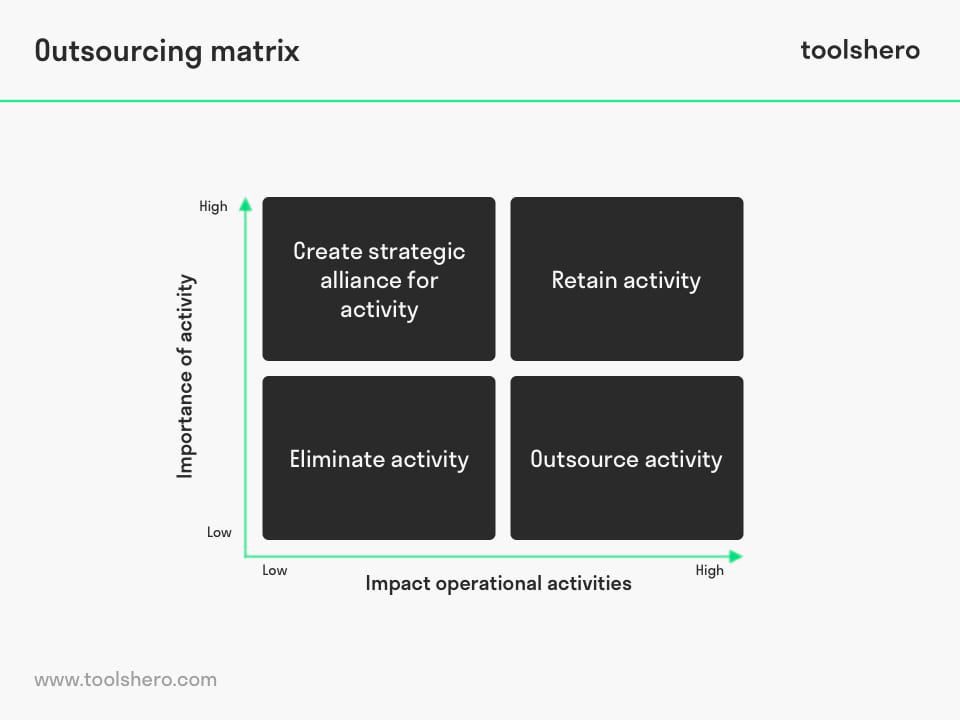Outsourcing explained including definition

Outsourcing: this article provides a practical explanation of outsourcing. Next to what it (definition) is, this article also highlights why this interesting is, outsourcing versus Offshoring, a decision matrix and the advantages. After reading, you’ll have a basic understanding of this strategic management activity. Enjoy reading!
What is outsourcing?
Definition of outsourcing
Outsourcing is the hiring of an external party to carry out planned activities such as manufacturing goods or providing services. It often involves a business agreement describing all the responsibilities of both parties.
An important question for many businesses is whether outsourcing will save them money, or whether it’s financially more interesting to do or produce something themselves.
Because many external parties are able to offer services or manufacture products at lower prices, outsourcing can apply to a wide range of activities, including customer service, manufacturing, back office, IT, and HRM.
Outsourcing is also called Business Process Outsourcing. This term was first suggested as a business strategy, or rather a part of it, in 1989. It was soon accepted and became an integral part of business economics.
Outsourcing has generated a lot of controversy. Proponents claim that outsourcing is an opportunity for organisations to assign resources in ways that make them the most effective. Opponents argue that this business activity has contributed to the loss of domestic jobs in certain countries.
Why is Outsourcing interesting?
Outsourcing business activities is an efficient and effective process that lets both parties use their resources in the most effective way. It’s also a sustainable process. It helps organisations to achieve their objectives and goals by, on the one hand, reducing costs, and on the other, increasing productivity.
At a macro level, the advantage of outsourcing is that it benefits the local economy of the host country where the production takes place on behalf of another company.
Outsourcing also has personal advantages. For instance, it can give a young worker in India the opportunity to work for a major American or European company. This helps reveal talent more easily than before, making it possible to use this talent in the most effective way.
Because of this business activity certain processes abroad, companies will also be less vulnerable to volatility and uncertainty in their own country.
Outsourcing versus Offshoring
Outsourcing and offshoring are often used interchangeably. While both are strategies, they are completely different. Sourcing something out is about delegating business processes and other activities to a different organisation. This is done, for instance, to focus on core business activities or to reduce costs.
Offshoring on the other hand refers to when organisations move certain business processes abroad. It’s often done to achieve a reduction in costs. In the case of offshoring, the business processes are carried out abroad by the organisation itself. In the case of outsourcing, a different organisation performs the work.
Outsourcing Decision Matrix (ODM)
The choice whether or not to outsource a process or activity is an important one and can have far-reaching effects on the company’s results. The Outsourcing Decision matrix can help with making the right decision.
Two Criteria
When assessing a situation in which business activities may potentially be outsourced, it’s important to carefully consider the matrix displayed below. Two elements in the matrix are important to the decision.
The first is the importance of the activity. Is it an activity that provides the organisation with a strategic or competitive advantage? Or is it a normal, routine activity? This criterium is shown alongside the vertical axis.
The second criterion can be found on the horizontal line and lets users question the impact of the activity on the company’s daily activities. In other words, will outsource something be detrimental to the smooth functioning of the organisation?

Figure 1 – the Outsourcing Decision Matrix
Based on the two criteria, the best choice becomes visible in this matrix. Normally, an organisation that’s in a position that involves this choice can opt for the following four options:
Strategic Alliance
Activities here are of strategic importance, but contribute little to the internal performance of the organisation. It is important to always have access to these activities, but it’s not a crucial part of the business. Therefore these activities may be outsourced to a reliable partner.
Retain Activity
The activities in this category are strategically important and contribute significantly to the company’s performance. It is therefore a crucial activity that directly impacts both the results and the flow of the organisation. These activities have to be done in-house to retain full control.
Eliminate Activity
Activities in this quadrant aren’t important for the organisation’s performance, don’t offer a competitive advantage, and contribute little to the work processes. If possible, these activities may be eliminated to reduce costs.
Outsource Activity
These activities are important to the performance of the organisation, but not so much strategically. This means that the organisation should consider outsourcing these.
Advantages of Outsourcing
Many business use outsourcing as a strategy to gain a strong competitive edge. In this case, the parties who are outsourced to are considered strategic partners instead of mere contract partners. Companies that don’t necessarily use outsourcing as a strategy, but outsource certain activities also enjoy a number of advantages:
- Reducing costs and increasing control
- Maintaining and improving focus on key activities
- Scouting talents
- Reducing and sharing risks
- Using resources more efficiently
- Improving the availability of other resources
- Access to new markets
- Embracing improved productivity
- Gathering important feedback (customer service)
- Flexibility
Now it’s your turn
What do you think? Are you familiar with the explanation of outsourcing? What do you believe are some of the pros and cons of this business strategy?
Share your experience and knowledge in the comments box below.
More information
- Quinn, J. B., & Hilmer, F. G. (1994). Strategic outsourcing. MIT Sloan Management Review, 35(4), 43.
- Feenstra, R. C., & Hanson, G. H. (1996). Globalization, outsourcing, and wage inequality (No. w5424). National Bureau of Economic Research.
- Lacity, M. C., & Hirschheim, R. (1993). The information systems outsourcing bandwagon. Sloan management review, 35, 73-73.
- Chow, R., Golle, P., Jakobsson, M., Shi, E., Staddon, J., Masuoka, R., & Molina, J. (2009, November). Controlling data in the cloud: outsourcing computation without outsourcing control. In Proceedings of the 2009 ACM workshop on Cloud computing security (pp. 85-90). ACM.
- Grossman, G. M., & Helpman, E. (2005). Outsourcing in a global economy. The Review of Economic Studies, 72(1), 135-159.
How to cite this article:
Janse, B. (2019). Outsourcing. Retrieved [insert date] from Toolshero: https://www.toolshero.com/management/outsourcing/
Original publication date: 06/20/2021 | Last update: 04/14/2023
Add a link to this page on your website:
<a href=”https://www.toolshero.com/management/outsourcing/”>Toolshero: Outsourcing</a>













One response to “Outsourcing explained including definition”
I think outsourcing is the best possible way to hire trained experts at a cheaper cost. I am outsourcing the finance and bookkeeping work to India and it’s quite feasible. Great post